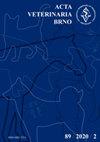冬眠/冬眠周期可能增加蝙蝠使用杀虫剂的风险:一项体外研究
IF 0.7
4区 农林科学
Q3 VETERINARY SCIENCES
引用次数: 0
摘要
暴露于污染物被认为是蝙蝠数量下降的潜在原因之一。在之前研究的背景下,我们设法创建并保存了大量来自欧洲蝙蝠物种的细胞系。选择肝细胞进行测试,因为它们代表了毒理学研究的首选模型。蝙蝠受到保护,细胞系取代了实验动物,因此提供了一个独特的机会来检查动物暴露在环境中的污染物的影响。此外,细胞孵育温度的变化可以模拟异温蝙蝠的生理状态。培养肝细胞系至所需细胞数。采用5种不同浓度的氯菊酯(PM)和吡虫啉(IMI),分别在37℃和8℃条件下培养24 h,测定杀虫剂对夜蛾肝细胞的细胞毒性作用。在37°C和8°C条件下,IMI的细胞毒性分别为0% ~ 47%和56% ~ 67%。在37℃和8℃条件下,PM的细胞毒性分别为36% ~ 56%和43% ~ 88%。氯菊酯在细胞上的浓度降低了一个数量级;尽管如此,仍记录到较高程度的细胞毒性。吡虫啉在冬眠温度下对蝙蝠肝细胞的毒性大于体温37℃时的毒性。本文章由计算机程序翻译,如有差异,请以英文原文为准。
Torpor/hibernation cycle may enhance the risk of insecticides for bats: an in vitro study
Exposure to pollutants is considered one of the potential reasons of population declines in bats. In the context of previous studies, we managed to create and keep a wide collection of cell lines from European bat species. Liver cells were chosen for testing, as they represent the preferred model for toxicological studies. Bats are protected, cell lines replacing experimental animals thus represent a unique opportunity to examine effects of pollutants which animals are exposed to in their environments. Moreover, cell incubation temperature variation may simulate physiological states of heterothermic bats. Liver cell lines were cultivated to the required cell number. Exposure to five different concentrations of permethrin (PM) and imidacloprid (IMI) were used to determine cytotoxic effects of these pesticides on Nyctalus noctula-derived liver cells cultivated at 37 °C and 8 °C for 24 h. An assay based on the measurement of activity of lactate dehydrogenase released from damaged cells was used for quantitating cytotoxicity. Cytotoxicity of IMI ranged from 0% to 47% and from 56% to 67% at 37 °C and 8 °C, respectively. Cytotoxicity of PM ranged from 36% to 56% and from 43% to 88% at 37 °C and 8 °C, respectively. Permethrin was tested on the cells at an order of magnitude lower concentrations; even so, higher degree of cytotoxicity was recorded. Imidacloprid was more toxic to bat liver cells at a hibernation temperature than at body temperature of 37 °C.
求助全文
通过发布文献求助,成功后即可免费获取论文全文。
去求助
来源期刊

Acta Veterinaria Brno
农林科学-兽医学
CiteScore
1.00
自引率
33.30%
发文量
36
审稿时长
18-36 weeks
期刊介绍:
ACTA VETERINARIA BRNO is a scientific journal of the University of Veterinary and Pharmaceutical Sciences in Brno, Czech Republic.
The scientific journal Acta Veterinaria Brno is dedicated to the publication of original research findings and clinical observations in veterinary and biomedical sciences. Original scientific research articles reporting new and substantial contribution to veterinary science and original methods that have not been submitted for publication elsewhere are considered for publication. A written statement to this effect should accompany the manuscript, along with approval for publication by the author´s head of department. The authors bear full responsibility for the contents of their contribution. Book reviews are published, too.
 求助内容:
求助内容: 应助结果提醒方式:
应助结果提醒方式:


